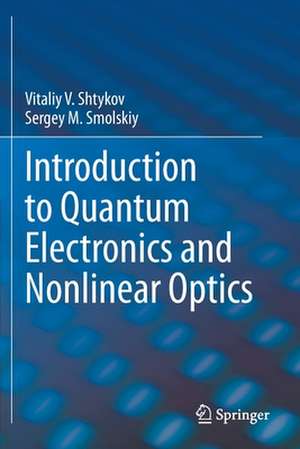Introduction to Quantum Electronics and Nonlinear Optics
Autor Vitaliy V. Shtykov, Sergey M. Smolskiyen Limba Engleză Paperback – 23 mar 2021
The book takes the semi-classical approach where light is treated as a wave in accordance with the classical Maxwell equations, while matter is governed by quantum theory. It begins by introducing the postulates and mathematical framework of quantum theory, followed by the formalism of the density matrix which allows the transition from microscopic (quantum) quantities to macroscopic (classical) ones. Consequently, the equations describing the reaction of matter to the electromagnetic field in the form of polarization, magnetization, and current are derived. These equations (together with the Maxwell equations) form the complete system of equations sufficient to model a wide class of problems surrounding linear and nonlinear interactions of electromagnetic fields with matter. The nonlinear character of the governing equations determines parameters of the steady-state mode of the quantum generator and is also demonstrated in harmonic generation via propagation of laser radiation in various media. The touchstone description of magnetic phenomena will be of interest to scientists who deal with applications of magneto-resonance phenomena in biology and medicine.
Other advanced topics covered include electric dipole transitions, magnetic dipole transitions, plasma transitions, and the devices that can be based on these and other electro-optical and nonlinear-optical systems. This textbook features numerous exercises, some of which are investigatory and some of which require computational solutions.
| Toate formatele și edițiile | Preț | Express |
|---|---|---|
| Paperback (1) | 586.38 lei 6-8 săpt. | |
| Springer International Publishing – 23 mar 2021 | 586.38 lei 6-8 săpt. | |
| Hardback (1) | 592.77 lei 6-8 săpt. | |
| Springer International Publishing – 23 mar 2020 | 592.77 lei 6-8 săpt. |
Preț: 586.38 lei
Preț vechi: 689.86 lei
-15% Nou
Puncte Express: 880
Preț estimativ în valută:
112.22€ • 117.01$ • 93.26£
112.22€ • 117.01$ • 93.26£
Carte tipărită la comandă
Livrare economică 21 martie-04 aprilie
Preluare comenzi: 021 569.72.76
Specificații
ISBN-13: 9783030376161
ISBN-10: 3030376168
Pagini: 323
Ilustrații: XXIV, 323 p. 146 illus., 7 illus. in color.
Dimensiuni: 155 x 235 mm
Greutate: 0.49 kg
Ediția:1st ed. 2020
Editura: Springer International Publishing
Colecția Springer
Locul publicării:Cham, Switzerland
ISBN-10: 3030376168
Pagini: 323
Ilustrații: XXIV, 323 p. 146 illus., 7 illus. in color.
Dimensiuni: 155 x 235 mm
Greutate: 0.49 kg
Ediția:1st ed. 2020
Editura: Springer International Publishing
Colecția Springer
Locul publicării:Cham, Switzerland
Cuprins
Dedication.- Acknowledgments.- About the Authors.- Preface.- Introduction.- 1: Excursus to the Atomic-Molecular Theory of Substance.- 2: Interaction of Electrical Dipoles.- 3: Magnetic Dipole Interaction.- 4: Field Interaction with "Free Charges".- 5: Quantum Amplifiers and Generators.- 6: Nonlinear Interaction of Electromagnetic Waves with a Substance.- 7: Some Types of Quantum Generators and Amplifiers.- Appendices.- - Index.
Recenzii
“The book has a crystal-clear style and can be understood by any student with a basic physics and mathematical background.” (Mircea Dragoman, Optics & Photonics News, osa-opn.org, August 6, 2020)
Notă biografică
Sergey M. Smolsky graduated from the Radio Engineering Faculty of Moscow Power Engineering Institute in 1970. He is Dr. Sci. (Eng), professor of the Radio Signal Generation and Processing Dept. of the Institute of Radio Engineering and Electronics in the National Research University “MPEl”. His scientific interests are autodyne and radar theory, telecommunications, nonlinear oscillation theory, chaotic systems, radio physics and signal processing, radiowaves propagation.
Vitaly V. Shtykov received his Ph.D. (Techn.) in 1970. Now he works as a full-time professor at the Moscow Power Engineering Institute (MPEI). He has more than 200 publications and 21 patents.
Textul de pe ultima copertă
This textbook, based on the authors’ class-tested material, is accessible to students at the advanced undergraduate and graduate level in physics and engineering. While its primary function is didactic, this book’s comprehensive choice of topics and its clear and authoritative synthesis of ideas make it a useful reference for researchers, device engineers, and course instructors who wish to consolidate their knowledge of this field.
The book takes the semi-classical approach where light is treated as a wave in accordance with the classical Maxwell equations, while matter is governed by quantum theory. It begins by introducing the postulates and mathematical framework of quantum theory, followed by the formalism of the density matrix which allows the transition from microscopic (quantum) quantities to macroscopic (classical) ones. Consequently, the equations describing the reaction of matter to the electromagnetic field in the form of polarization, magnetization, and current are derived. These equations (together with the Maxwell equations) form the complete system of equations sufficient to model a wide class of problems surrounding linear and nonlinear interactions of electromagnetic fields with matter. The nonlinear character of the governing equations determines parameters of the steady-state mode of the quantum generator and is also demonstrated in harmonic generation via propagation of laser radiation in various media. The touchstone description of magnetic phenomena will be of interest to scientists who deal with applications of magneto-resonance phenomena in biology and medicine.
Other advanced topics covered include electric dipole transitions, magnetic dipole transitions, plasma transitions, and the devices that can be based on these and other electro-optical and nonlinear-optical systems. This textbook features numerous exercises, some of which are investigatory and some of which require computational solutions.
Caracteristici
Includes exercises to test both theoretical and computational understanding Suitable as a textbook or recommended reading for a range of courses related to quantum electronics and devices Presents a comprehensive list of topics in a cohesive framework to show the unity of the subject
